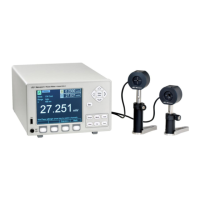Principles of Operation 127 127
9.10.6 Signal Filtering
The 1936/2936 Series offer the user the option to filter the detector signal.
There are two programmable filters that can be used individually or together
to condition the detector signal: the Analog Filter and the Digital Filter.
The Analog Filter is hardware based programmable low-pass filer. The user
can select the following settings: 5 Hz, 1 kHz, 12.5 kHz, and 250 kHz.
This flexibility is offered to the user to improve the measurement precision
for different detectors.
It is well known that white noise has large spectrum. The noise level
increases with bandwidth. The higher the noise, the higher the minimum
signal that can be measured. The quality of the measurement can be linked to
the signal-to-noise ratio (SNR): the higher the SNR, the better the
measurement precision of very small signals. In order to increase the SNR the
user may choose to cut the bandwidth of the meter, depending on the detector
signal.
For example, if the detector is modulated with a sine wave of 800 Hz, the
user may choose to set the Analog filter to 1 kHz to increase the SNR and be
able to measure very small signals. Also, cutting the bandwidth at 1 kHz does
not affect the measurement. However, if the modulation frequency is 800 Hz,
but the signal is a square, the user may opt to cut the bandwidth higher, at
12.5 kHz, to let the signal harmonics be unfiltered and minimize the
distortion. Of course, in this case, the noise in the system will increase with
the square root of the bandwidth. The user needs to asses the tradeoffs in his
measurement, taking advantage of the 1936/2936 Series high flexibility in
setting the proper filters for the measurement.
Generally, the 5 Hz filter is used for CW Cont. measurements. However, the
1936/2936 Series can measure the amplitude of AC signals down to 0.01 Hz,
so the 5 Hz filter can be used for any modulating signal below 5 Hz.
The Digital Filter is a moving average filter that can be set at 10, 100, 1000,
or 10000 measurements. These values can be changed by the user. If the
digital filter is set on 10, the average value is computed on 10 measurements,
in a First In First Out (FIFO) fashion. The Digital Filter helps the SNR the
same way as the Analog Filter does. With both filters on, low level,
continuous signals can be measured with a high degree of accuracy.
The Analog Filter is always applied to the entire amplifier chain of the meter.
Therefore, the user will see the detector signal filtered at the Analog Output
BNC. The Digital Filter is a digital signal-processing filter and is only
applied to the calculated measured values that are displayed on the meter
screen. While the displayed values may have both filters applied (An+Dg) the
Analog Output can only have the Analog Filter applied to the signal. Because
of that, the user may see a difference in the way the signal is filtered between
the displayed values and the Analog Output values.

